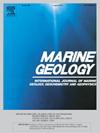The utility of mangrove foraminifera, diatoms, and stable carbon isotope and C/N geochemistry in relative sea-level reconstruction in the Pearl River Delta, China
IF 2.2
3区 地球科学
Q2 GEOSCIENCES, MULTIDISCIPLINARY
引用次数: 0
Abstract
We investigated the utility of foraminifera, diatoms, and δ13C and C/N geochemistry as proxies for generating late Holocene relative sea-level (RSL) records from Deep Bay on the eastern side of the Pearl River Delta. We described the contemporary distribution of these proxies from 66 samples across subtidal, intertidal (mudflat and mangrove), and upland environments from three transects. Using Partitioning Around Medoids (PAM) cluster analysis, we identified ten distinct, vertically-zoned groups of foraminifera and two groups of diatoms. Canonical Correspondence Analysis (CCA) revealed that tidal elevation was the primary environmental variable controlling foraminiferal assemblages, while salinity, which covaried with elevation, primarily influenced diatom assemblages. We also identified 6 vertically-zoned, environmental zones on the basis of δ13C and C/N geochemistry using linear discriminant analysis (LDA). Bayesian transfer functions (BTFs) were developed from modern foraminifera and diatom training sets incorporating priors from geochemically-defined environmental zones and BTF predictions derived from the other microfossil group. These BTFs were applied to a sediment core collected from contemporary mangroves, which began accumulating around 1960 CE. Comparison of our RSL reconstructions with local tide gauge records demonstrated that incorporating informative priors improved the accuracy and precision of RSL reconstructions. Among the approaches tested, microfossil BTF-derived priors yielded greater improvement, producing lower prediction uncertainties compared to those based on geochemical priors. The foraminifera BTF captured all tide gauge observations within its 1σ uncertainty bounds regardless of whether informed by priors, while using diatom BTF priors led to a reduction in Mean Squared Error (MSE) by 121 % (MSE: 0.014 m2), and average 1σ uncertainty by 36 %. The incorporation of foraminifera BTF priors in the diatom BTF did not result in substantial improvements in accuracy but reduced its average 1σ uncertainty by 43 %. Our results demonstrate that foraminifera, diatoms, and δ13C and C/N geochemistry together offer robust tools for reconstructing late Holocene RSL in the Pearl River Delta, although their utility in isolation is limited by poor preservation of foraminiferal tests and the influence of planktonic diatom taxa in sediment archives.
珠江三角洲红树林有孔虫、硅藻、稳定碳同位素和碳氮地球化学在相对海平面重建中的应用
利用有孔虫、硅藻、δ13C和C/N等地球化学指标对珠江三角洲东侧后海湾晚全新世相对海平面(RSL)记录进行了研究。我们从三个样带的66个样本中描述了这些代用物在潮下、潮间带(泥滩和红树林)和高地环境中的当代分布。通过聚类分析(PAM),我们鉴定出10个不同的有孔虫群和2个硅藻群。典型对应分析(CCA)表明,潮汐高度是控制有孔虫组合的主要环境变量,而盐度主要影响硅藻组合,盐度随海拔高度的变化而变化。利用线性判别分析(LDA),在δ13C和C/N地球化学特征的基础上,确定了6个垂直带状的环境带。贝叶斯传递函数(BTF)是由现代有孔虫和硅藻训练集发展而来的,该训练集结合了地球化学定义的环境带的先验和来自其他微化石组的BTF预测。这些btf被应用于从当代红树林收集的沉积物岩心,这些沉积物在公元1960年左右开始积累。与当地验潮仪记录的比较表明,信息先验提高了RSL重建的精度和精度。与地球化学方法相比,基于微化石btf的预测方法具有更大的改进,预测不确定性更低。有孔虫BTF捕获了1σ不确定性范围内的所有潮汐测量值,而使用硅藻BTF先验使均方误差(MSE)降低了121% (MSE: 0.014 m2),平均1σ不确定性降低了36%。在硅藻BTF中加入有孔虫BTF先验并没有显著提高精度,但使其平均1σ不确定度降低了43%。研究结果表明,有孔虫、硅藻和δ13C和C/N地球化学共同为重建珠江三角洲晚全新世RSL提供了强有力的工具,尽管有孔虫实验的保存不佳以及沉积物档案中浮游硅藻类群的影响限制了它们的单独效用。
本文章由计算机程序翻译,如有差异,请以英文原文为准。
求助全文
约1分钟内获得全文
求助全文
来源期刊

Marine Geology
地学-地球科学综合
CiteScore
6.10
自引率
6.90%
发文量
175
审稿时长
21.9 weeks
期刊介绍:
Marine Geology is the premier international journal on marine geological processes in the broadest sense. We seek papers that are comprehensive, interdisciplinary and synthetic that will be lasting contributions to the field. Although most papers are based on regional studies, they must demonstrate new findings of international significance. We accept papers on subjects as diverse as seafloor hydrothermal systems, beach dynamics, early diagenesis, microbiological studies in sediments, palaeoclimate studies and geophysical studies of the seabed. We encourage papers that address emerging new fields, for example the influence of anthropogenic processes on coastal/marine geology and coastal/marine geoarchaeology. We insist that the papers are concerned with the marine realm and that they deal with geology: with rocks, sediments, and physical and chemical processes affecting them. Papers should address scientific hypotheses: highly descriptive data compilations or papers that deal only with marine management and risk assessment should be submitted to other journals. Papers on laboratory or modelling studies must demonstrate direct relevance to marine processes or deposits. The primary criteria for acceptance of papers is that the science is of high quality, novel, significant, and of broad international interest.
 求助内容:
求助内容: 应助结果提醒方式:
应助结果提醒方式:


